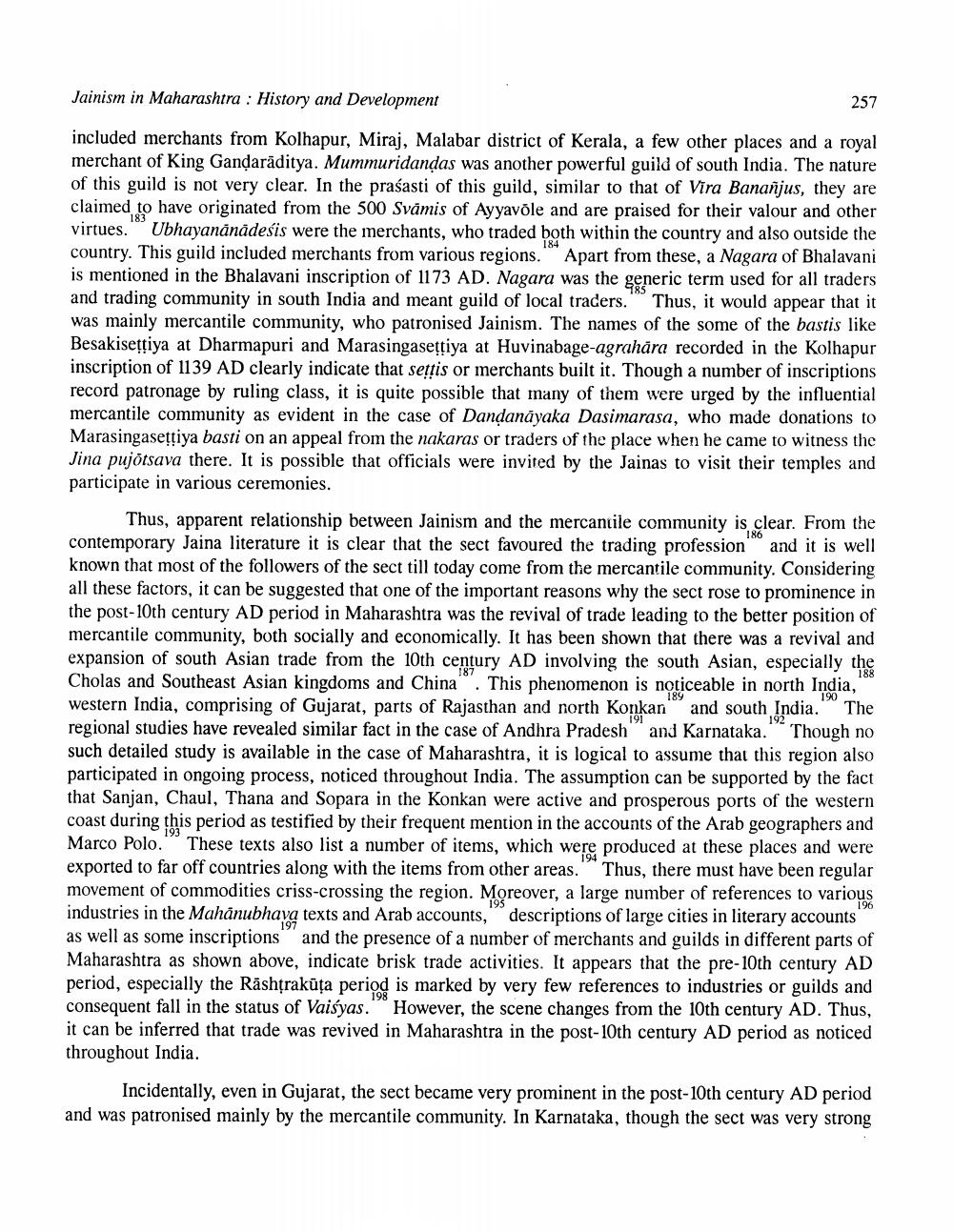________________
Jainism in Maharashtra : History and Development
257
included merchants from Kolhapur, Miraj, Malabar district of Kerala, a few other places and a royal merchant of King Gandarāditya. Mummuridandas was another powerful guild of south India. The nature of this guild is not very clear. In the praśasti of this guild, similar to that of Vira Banańjus, they are claimed to have originated from the 500 Svāmis of Ayyavole and are praised for their valour and other virtues. Ubhayanānādesis were the merchants, who traded both within the country and also outside the country. This guild included merchants from various regions. Apart from these, a Nagara of Bhalavani is mentioned in the Bhalavani inscription of 1173 AD. Nagara was the generic term used for all traders and trading community in south India and meant guild of local traders. Thus, it would appear that it was mainly mercantile community, who patronised Jainism. The names of the some of the bastis like Besakisettiya at Dharmapuri and Marasingasettiya at Huvinabage-agrahāra recorded in the Kolhapur inscription of 1139 AD clearly indicate that settis or merchants built it. Though a number of inscriptions record patronage by ruling class, it is quite possible that many of them were urged by the influential mercantile community as evident in the case of Dandanayaka Dasimarasa, who made donations to Marasingasettiya basti on an appeal from the nakaras or traders of the place when he came to witness the Jina pujõtsava there. It is possible that officials were invited by the Jainas to visit their temples and participate in various ceremonies.
Thus, apparent relationship between Jainism and the mercantile community is clear. From the contemporary Jaina literature it is clear that the sect favoured the trading profession and it is well known that most of the followers of the sect till today come from the mercantile community. Considering all these factors, it can be suggested that one of the important reasons why the sect rose to prominence in the post-10th century AD period in Maharashtra was the revival of trade leading to the better position of mercantile community, both socially and economically. It has been shown that there was a revival and expansion of south Asian trade from the 10th century AD involving the south Asian, especially the Cholas and Southeast Asian kingdoms and China. This phenomenon is noticeable in north India, western India, comprising of Gujarat, parts of Rajasthan and north Konkan and south India. The regional studies have revealed similar fact in the case of Andhra Pradesh and Karnataka." Though no such detailed study is available in the case of Maharashtra, it is logical to assume that this region also participated in ongoing process, noticed throughout India. The assumption can be supported by the fact that Sanjan, Chaul, Thana and Sopara in the Konkan were active and prosperous ports of the western coast during this period as testified by their frequent mention in the accounts of the Arab geographers and Marco Polo. These texts also list a number of items, which were produced at these places and were exported to far off countries along with the items from other areas. Thus, there must have been regular movement of commodities criss-crossing the region. Moreover, a large number of references to various industries in the Mahanubhava texts and Arab accounts, descriptions of large cities in literary accounts as well as some inscriptions and the presence of a number of merchants and guilds in different parts of Maharashtra as shown above, indicate brisk trade activities. It appears that the pre-10th century AD period, especially the Räshțrakūţa period is marked by very few references to industries or guilds and consequent fall in the status of Vaisyas. However, the scene changes from the 10th century AD. Thus, it can be inferred that trade was revived in Maharashtra in the post-10th century AD period as noticed throughout India.
Incidentally, even in Gujarat, the sect became very prominent in the post-10th century AD period and was patronised mainly by the mercantile community. In Karnataka, though the sect was very strong




